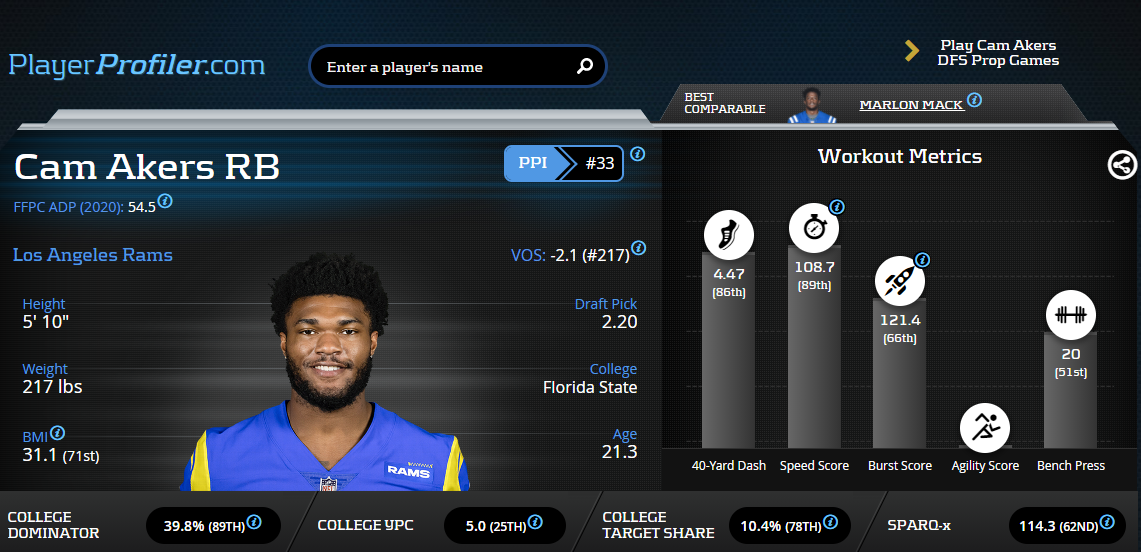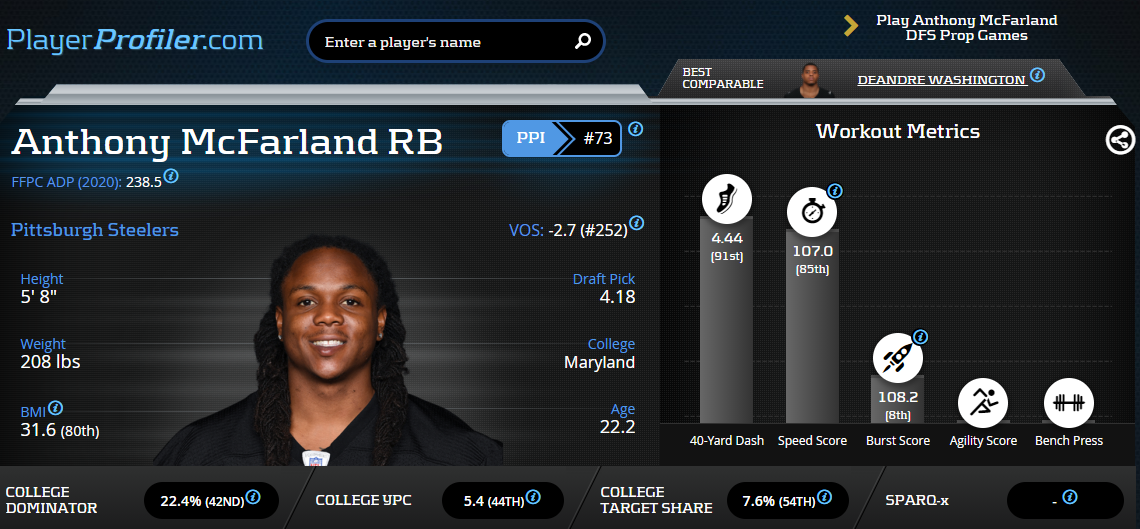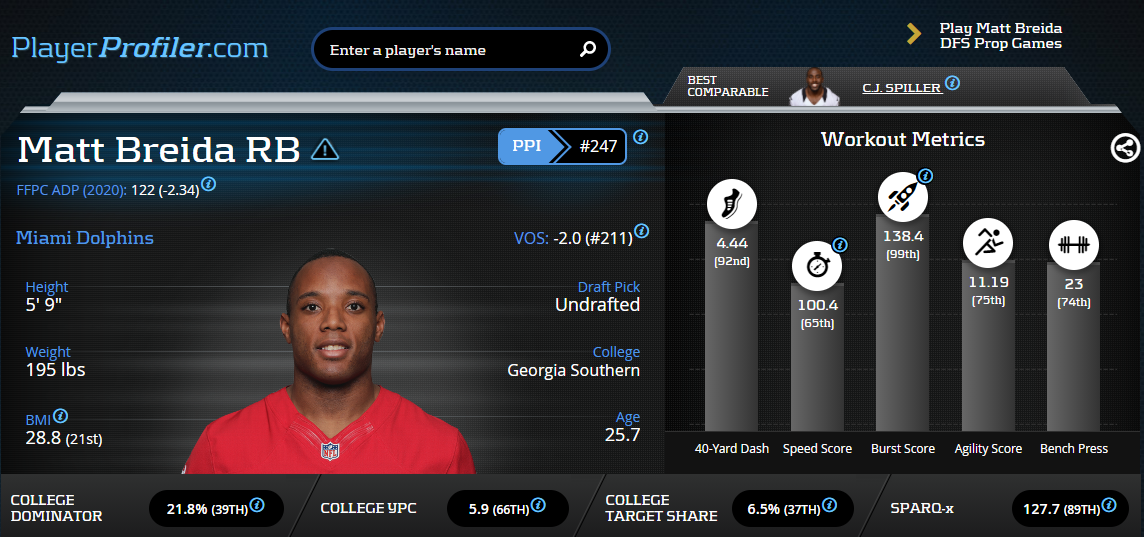(In this new Metric of the Week series, one of our writers will choose one of PlayerProfiler’s advanced stats and metrics and lay out a real-world application of the metric in fantasy analysis).
For some, this portion of the season brings along with it a creeping feeling that they may have been sorely mistaken on those Flag Plants they so smugly planted on Twitter this summer. The good news is, much of what drives the current player value is based on fantasy points scored. Which is volatile and not entirely predictive of future fantasy production, especially in such a small sample size. Even better news, Playerprofiler offers “stealth” advanced metrics, such as Juke Rate, that provide a more nuanced and clearer snapshot of backfield situations. The predictive value of Juke Rate has been quantified, but it is hard to not also see its qualitative value.
Juke Rate is a measure of how often a player makes an opposing defender miss, whether it be through power, speed or quickness, on a per touch basis. It is “RB talent” in its purest quantifiable form, agnostic of the more random breakaway runs, offensive line play, touchdown scoring and injury luck that muddies running back evaluation. Incorporating Juke Rate with other useful metrics, such as Opportunity Share, Route Participation, Yards per Route Run and Speed Score, clarifies the true value of a running back’s recent workload, how well the running back has utilized said workload, and which running backs would most excel with an increase in opportunity.
Buy (Most Of) The Rookies
The 2020 running back class has been a disappointment relative to their wide receiver counterparts and the massive offseason expectations. Much of the hype is warranted, with the class profiling strongly from a college production and athletic standpoint. In fact, many of the rookies are confirming their strong priors with strong performance in the key NFL advanced metrics, providing a massive buying opportunities in leagues with impatient owners.
J.K. Dobbins
J.K. Dobbins has been tethered to a three-headed running back split with Mark Ingram and Gus Edwards. His Snap Share has dropped from 53.1-percent in Week 3 to 26.2-percent in Week 5. There is still room for optimism, however. The Ravens have played in five blowout/borderline blowout games, so the opportunity-based metrics up to this point are less reliable. Also, Ingram is a 30-year old running back with a 16.7-percent (No. 39 among qualified running backs) Juke Rate, and Edwards is limited to a specialized role as an early down grinder. Meanwhile, Dobbins has a 32.0-percent Juke Rate and has run 57 (No. 36) routes, more than Ingram and Edwards have combined. What makes Dobbins’ outlook in particular so promising is that he, unlike most running backs stuck in a committee, does not necessarily need an injury to earn a workhorse role.
Check out J.K. Dobbins on PlayerProfiler’s Updated Weekly Rankings and Projections:
Dobbins has already secured the valuable pass-catching role, and it’s not hard not imagine a scenario where John Harbaugh eventually hands over the keys to their second-round draft pick. With his 28.4-percent (63rd-percentile) College Dominator Rating at Ohio State, Dobbins profiles as a workhorse back. His strong showing in Graham Barfield’s College Yards Created analysis and 3.68 College Yards per Team Attempt (courtesy of Peter Howard) demonstrates his capability of maintaining efficiency in a larger role. Despite Baltimore’s seemingly slow start, they still rank in the top half of the NFL in offensive Expected Points Added (EPA) per play. Even a partial return to the team’s 2019 glory would benefit the skill players.
A slow start for Dobbins was expected. However, it’s natural for owners to get antsy and second-guess themselves while a player wastes away on their bench. This is the moment to be aggressive. One strong showing can shift Dobbins’ season-long perception.
Cam Akers
For Cam Akers, his health and Darrell Henderson‘s perceived emergence have been the primary deterrents. The injury Akers sustained in Week 1, separated rib cartilage, shouldn’t linger. Henderson’s strong start has been misleadingly propped up by four (No. 9) touchdowns scored despite a 12.3-percent (No. 49) Juke Rate and having exceeded above a Snap Share above 50.0-percent only once this season. The Los Angeles Rams’ preference toward the crushingly mediocre Malcolm Brown in Akers’ absence has continued to be a baffling development that speaks poorly on Henderson’s viability as a long term workhorse. Akers, with a 39.8-percent (89th-percentile) College Dominator Rating and 108.7 (89th-percentile) Speed Score, was a superior college prospect to Henderson.
As of Week 5, Akers sports a 29.6-percent (No. 14) Juke Rate, albeit in a low sample size. However, his strong showing in Graham Barfield’s College Yards Created analysis and his 3.68 College Yards per Team Attempt suggests that his impressive Juke Rate is no fluke. There is more room for Akers optimism when considering that the Rams offense currently ranks No. 5 in offensive EPA/play. In the PFF Forecast Podcast, George Chahrouri astutely pointed out that the team’s heightened emphasis on shorter passes off play-action and success after the catch has spurred their offense in 2020.
Jared Goff‘s Air Yards per Attempt has decreased from 7.7 in 2019 to 6.2 in 2020. While it’s fair to question the sustainability of this offensive philosophy, it will benefit those skill players who most often work in this more shallow depth of target range, including the running backs. Akers has not shown any involvement as a pass catcher thus far, but with a 10.4-percent (78th-percentile) College Target Share and 12.3-percent college receiving yard percentage, he’s more than capable.
Anthony McFarland
We’d be remiss to not also mention the most intriguing rookie sleeper in Anthony McFarland. My interest in the fourth-round Maryland Terrapin derives less from my mistrust of James Conner, who has been solid in a primary role in Pittsburgh, but more so in the absolutely monstrous role McFarland can inherit if Conner goes down. Despite Benny Snell‘s short-lived early-season hype, he remains a plodding early down grinder, whereas McFarland’s profile points to legitimate dynamism.
McFarland ran a 4.40 (91st-percentile) 40-Yard Dash at 208-pounds, sported an elite 3.99 College Yards per Team Attempt, and jumped out as a later-round steal in Graham Barfield’s College Yards Created analysis for the 2020 class. On 10 NFL touches, his Juke Rate is a gaudy 40.0-percent. In case you aren’t intrigued enough, Pittsburgh ranks No. 9 in offensive EPA/play as of Week 5.
Post-Post-Post-Hype Sleeper
Myles Gaskin has impressed thus far in a workhorse role with the Dolphins, but we need to curtail our certainty in this backfield situation, especially considering the small sample size of games and that Gaskin has not had a history of workhorse usage. It would still likely take a Gaskin injury to shift opportunity in Miami, but Matt Breida would benefit.
Two in-season developments have sparked my interest in Breida. Firstly, Jordan Howard was a healthy scratch in Week 5, and there’s little competition behind Breida. Secondly, the Miami Dolphins are good, ranking No. 8 in offensive EPA/play behind the absolute flamethrower that is Ryan Fitzpatrick.
Breida’s solid 21.9-percent (No. 27) Juke Rate falls in line with his career average. He has carved out a receiving role in Miami, earning 72 (No. 33) receiving yards on 23 (No. 72) routes run. His strong 1.78 College Yards per Team Attempt further speaks to his potential in a hybrid role with the now-explosive Dolphins. Acquiring Breida has been made artificially easier by virtue of all the former scorned lovers vowing to never own another Breida share after having been burned by him in the recent past. This is ultimately juvenile thinking, but something very real psychologically. As Matt Kelley says, “I don’t hate players, I hate ADPs”. The delicious irony is that a player often breaks out when it’s least expected and as soon as we have ridden him off to pasture.






